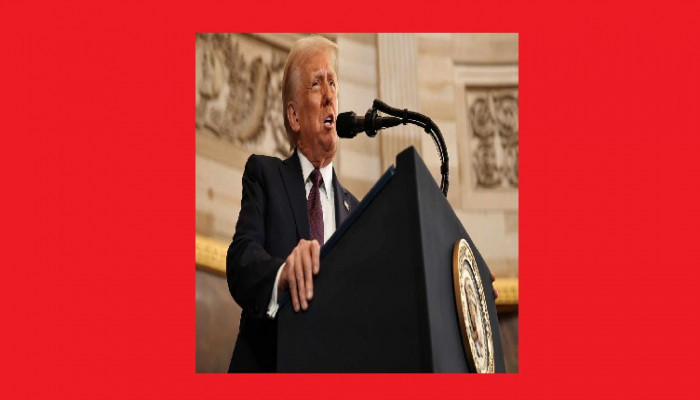- Jun 03, 2025
- Viren S Doshi
Featured Articles
US India Partnership - Synergistic Economic Interdependence of Self-reliant ‘Big Two’
The US and India are powerful democratic open market polities poised to shape a new world order based on human values with commitment to global peace, they are at the cusp of signing a trade agreement. While both these nations have come together as strategic allies, a sound understanding of each other is of vital importance to make their alliance into an all-weather partnership. In turn, a well-grounded strategic partnership can help them forge a fruitful economic partnership as two self-reliant nations with limited synergistic interdependence for collective seamless growth of “big two” complementary economies without any geopolitical strains. Let us first list out the currently important points for consideration by both nations for a stable strategic partnership. Important points for Strategic Partnership Self-reliant India / Atmanirbhar Bharat has its exemplary foreign policy shaped over decades of its experiences on the global chessboard. As an independent, free, open, democratic, meritocratic, sovereign, self-reliant, non-aligned / all-aligned nation committed to global peace, it has very well customised its stance one upon one besides its template based on general principles - non-expansionism, non-violence, no first use of nuclear, co-existence, vasudhaiva kutumbakam - world one family. India's relations with expansionist, exclusivist, undemocratic, opaque nations are on a different pedestal than its relations with like-minded democratic, open-market, free nations. While joining hands with an ally like the US, India and Indians have to rise above stereotypes and sentiments in sections of the Indian people. “Deep state, America is no friend with anyone, both the US and CCP are untrustworthy” blah..blah.. India and Indians must realise that the US is a liberal democracy and the US left wing has a different geopolitical agenda than that of conservative nationalists, just as is the case in India. The Nationalist government of India has a legacy of alliance with Russia, but that doesn't deter India from closely allying with US, Conservatives led US also have legacy allies like Turkey and Pakistan. India's alliance with Russia is not an entangling alliance. Democratic India is fully free to align with Democratic US, and India under the Modi Government is fully focused on forging inalienable ties with the US under Trump Administration. It is reassuring that the Trump Administration is keen on improving ties with Putin-led Russia and is continuously revisiting its alliance with Pakistan, and probably Turkey too. This is the time to build an inalienable strategic relationship as two free, self-reliant democracies. Americans under the nationalist administration have a foreign policy template - their anti-colonial founding fathers had emphatically stated that they didn't want US to enter into any entangling alliances. They were committed to global peaceful order. American foreign policy for democratic nations is to be on a different pedestal. How can Americans broaden and deepen their understanding about India and build stable strategic partnership without making it entangling alliance and still combat transnational expansionist forces like the red-green nexus? American geopolitical perspective on South Asia must take note that "Chinese Communist Party occupied China" is as much and more hovering across Tibet onto its Southern terrestrial border with India and South Asia as it does in the Southern Coastal border in the Indo-Pacific. Americans view India as a regional power in South Asia but it must be viewed as a nation in South Asia directly facing expansionist global super power viz. CCP-occupied China, day in and day out. India in South Asia is what Taiwan is in the Indo-Pacific, what Israel is in the Middle East and what Russia is in East Europe. Americans must know Mainland China was occupied by the CCP, which then further occupied East Turkestan, Tibet, Shaksgam, Aksai Chin and is still eyeing to occupy more Indian territories like Ladakh and Arunachal. America's main adversary CCP, is also playing sinister games in entire South Asia. India's surroundings are targeted by the CCP to make them hostile towards India. Americans must know that India and Pakistan are two nuclear powers in South Asia but that doesn't justify hyphenating democratic India with Jihadi terrorist Pakistan. Assume that Iran is nuclear in the Middle East or Singapore is nuclear in the Indo-Pacific or Ukraine is nuclear in Eastern Europe. That doesn't give respite but rather increases the pains of Israel, Taiwan and Russia. Nuclear, terrorist Pakistan increases India's pains. India's nuclear weapons, like Israel & Russia, are solely for its self-defence in a quagmire with multiple undemocratic, opaque, hostile fronts. (Taiwan should also have a strong nuclear deterrent to ward off the expansionist CCP.) Russia took control of Zaporozhia, Israel destroyed Iranian nuclear facilities, while India has nuclear Pakistan staring at Delhi to wage Ghazwa-e-Hind as a stooge of the CCP. Americans must realise that Nuclear Pakistan in South Asia under Jihadi corrupt armed forces is more dangerous than Nuclear Iran under Ayatollahs in the Middle East or nuclear Ukraine / European Colonialists in East Europe under Colonialist dictators. CCP and Erdogan's Turkey are directly militarily allied with Pakistan in an iron-clad partnership, unlike in the case of Iran, which is supported by the CCP indirectly by way of trade and other means. Americans should recall that Pakistan was born out of India due to British Colonial politics, just as Palestine was born out of Israel due to a British Mandate. Palestine is never willing to accept the existence of Israel and Pakistan is not willing to accept the existence of India. It attacked India just after it was formed out of the vivisection of India in 1947. And it has been doing so continuously since then. India and Israel are best friends, Israel and the US are best friends, but the US is yet to realise that only India can be their friend in South Asia. Particularly when CCP's stooge Pakistan has spread its Islamic terrorist tentacles that it dons in the name of Kashmir; not only across India, but right across the seas to United Kingdom, other parts of Europe and the United States. Americans must know that India is dealing with multiple fronts - a superpower nuclear rogue opaque entity viz. CCP in the North, CCP's stooge nuclear terrorist Pakistan in the West and hostile Bangladesh in the East. Being a democratic nation, it is dealing with a half front at home; enemies taking undue advantage of its secularism, democracy and openness. As is the case in US. US’ Harvard is India's JNU - citadel of the enemy. The US must realise that South Asia is more perplexed and perplexing than the Middle East, Eastern Europe or Indo-Pacific. America needs to recalibrate its strategic position on India. Stop viewing India from the prism of a Pakistan or Afghanistan. View it as a nation facing CCP directly. Once the strategic partnership is properly calibrated and curated, the partners can turn to crystallise an economic partnership. Amid the upheavals due to positive global economic disruptions since the Trump Administration came to power in January 2025, emerging self-reliant democratic meritocratic open free independent big two US and India should now turn to a limited mutual synergistic geopolitical strain-free economic interdependence while carefully avoiding overdependence to make the strategic relationship strong and sustainable. Synergistic limited mutual economic interdependence between US and India Mapping synergy in economic partnership would be very relevant when the two nations are discussing a bilateral trade agreement. India's Foreign Secretary was in the US last week. Both nations agreed that Tech-Trade-Talent will shape the India-US partnership in the 21st century. USISPF, a joint non-profit forum, hosted a closed-door roundtable in Washington, D.C. with Vikram Misri, Foreign Secretary of India and Pavan Kapoor, Deputy National Security Advisor, Government of India. The dialogue focused on deepening U.S.-India cooperation in critical and emerging technologies under the TRUST initiative — advancing secure, transparent, and resilient innovation ecosystem through stronger government, industry and academic partnerships. The same forum is hosting more interactions this week. It would be pertinent and useful to have synergy mapping at this important juncture. The world's fourth-largest economy, with a GDP of $4.1 trillion, India is experiencing robust growth. U.S.-India bilateral trade, projected at $238 billion this year, is set to scale up to $500 billion by 2030. The US, with its advanced technology and capital, complements India's large, young workforce and growing market. Recent developments, such as the February 2025 United States-India Joint Leaders’ Statement, underscore the commitment to deepen economic ties, with both nations aiming to double bilateral trade under "Mission 500". The US and India can achieve synergistic interdependence across around 20 sectors. Cross-sectional Dimensions: Technology and Innovation: The US leads in research and development, particularly in semiconductors, AI, and quantum computing, while India has a vast pool of skilled IT and STEM professionals. Collaboration includes the U.S.-India Initiative on Critical and Emerging Technologies (iCET), focusing on AI, semiconductors, biotechnology, and clean energy. India’s IT services exports are expected to reach $199 billion in 2025, with Indian firms investing $80 billion in the US, employing over 400,000 people. Potential: Global innovation and job creation. Governance: Collaboration involves sharing best practices like India’s Right to Information Act and US anti-corruption frameworks to enhance transparency and democratic governance. India's DBT Direct Benefit Transfer program has helped cut wasteful spending. US DOGE experience is unique. Collaboration can be of synergistic value. Potential: Strengthen democratic institutions. Challenges: Political will and law enforcement. Supply Chain Resilience: Diversifying from CCP-occupied China, India can serve as an alternative in manufacturing and technology, reducing supply chain vulnerabilities for both nations. Challenges: Infrastructure, policy alignment. Climate Change and Sustainability: Joint efforts in carbon reduction and sustainable development can position both countries as leaders in global climate action, with coordinated policies and investments. Sectors: Defence: The US is a major defence exporter, with sales to India exceeding $20 billion since 2008. Recent agreements include the co-production of Stryker combat vehicles and the launch of INDUS-X for defence innovation. India and US have common strategic interests favouring strong defence development, manufacturing and trade collaboration, India has already imported transport aircrafts and helicopters. Potential: Strengthen regional security and reduce reliance on other suppliers who may be connected with CCP. Challenges: IP protection and R&D budget alignment. Rare Earths and Critical Minerals: Both countries face deficits in rare earths processing, with China controlling over 60% of global production and 90% of refining. The US-India Strategic Mineral Recovery program aims to enhance mining and processing, leveraging India’s reserves. Potential: Supply chain resilience and reduced dependence on CCP-occupied China. Clean Energy and Solar Power: India’s tropical location offers abundant solar potential (5,000 trillion kWh/year), complementing the US’s clean energy innovations. Collaborations include Vikram Solar’s $1.5 billion investment in US solar manufacturing and the U.S.-India Strategic Clean Energy Partnership (SCEP). Potential: Accelerate clean energy deployment and reduce carbon emissions. Challenges: Infrastructure gaps and policy alignment. Space: Joint missions include the NISAR satellite (NASA-ISRO partnership) and plans for an Indian astronaut on the ISS in 2025, with commercial space ventures expanding. Space is another sector where both have distinct edges to complement each other. Potential: Space economy leadership and technological advancement. Challenges: Regulatory alignment and technology transfer. Infrastructure: US investment in India’s smart cities and transportation systems can enhance connectivity, with India’s capital expenditure growing 17.1% in 2024-25. Ports and ship building can benefit by collaboration. Industry - Electronics etc.: Electronics, mechanics, power and automation has lot of potential for collaboration. In the electronics, with India’s Production Linked Incentive (PLI) scheme boosting electronics manufacturing, accounting for 18%-20% of industrial investment in the next five years, the scaling up could be phenomenal. Challenges: Tariff negotiations, market access. Automotive: Collaboration in electric vehicles (EVs) and autonomous driving aligns with sustainability goals, offering opportunities for technology transfer and market expansion. Potential: Green transportation. Challenges: Regulatory alignment, tech transfer. Telecommunications: Joint efforts in 5G and future 6G technologies can enhance digital connectivity, strengthening both nations’ digital economies. Potential: Strengthen digital highways. Challenges: Technology standards and competition. Cybersecurity: Shared interests in protecting digital economies necessitate joint frameworks for cybersecurity, addressing data privacy and cross-border cooperation. Potential: Global cybersecurity leadership. Agriculture: India is self-sufficient in dairy, fisheries, rice, and wheat but faces deficits in oilseeds and pulses. US, with its vast land and water resources and agritech prowess, can provide advanced agricultural technologies. Collaborations like the U.S.-India Agricultural Knowledge Initiative (AKI) support climate-smart agriculture and productivity growth. Regulators and trade negotiators must coordinate for streamlining agri partnership keeping in view indigenous farming practices, cultural and other social factors. Small family farm based agri sector is livelihood provider for large sections of millions of Indians unlike the factory like US farm sector that ensures hight productivity. Both models have input cost imperatives. Consumers at both ends have certain preferences based on scientific, cultural and religious factors. Mutual respect and understanding of these nuances can help restrict negotiations to synergistic interdependence without unnecessary disruptions. US as well as India both may be surplus in certain products and should avoid pressures for trade increase in these commodities as it can have adverse fallouts on livelihood opportunities, specifically in India. Potential: Enhance productivity and sustainability. Challenges: Trade imbalances and respect for local factors. Biotechnology: Joint R&D in biotechnology can address food security and environmental challenges, with potential for innovation in agriculture and healthcare. Challenges: IP protection and coordination. Pharmaceuticals, Healthcare and Soft Power Sectors: As leading producer of vaccines, India supplies over 50% of global vaccines and 40% of US generic drug demand, with exports to the US surging 15% to $7.83 billion in 2023-24. Collaboration includes vaccine production and drug discovery, with regulatory alignment between US and Indians pharma regulators being crucial. Yoga, Ayurveda, Philosophy, Indian Psychology, Indian Sociology - Indian Family System, Indian Music, Indian Culture, Indian Cuisine - all this is soft power of India and US can benefit from this for peaceful contented family based civilizational life while US can help India further mould its scientific vigour. Potential: Global health security and innovation. Challenges: Regulatory differences and IP concerns. Education: Over 300,000 Indian students study in the US, contributing $8 billion annually. Joint initiatives like the Women in Science, Technology, Engineering, Mathematics, and Medicine STEMM Fellowship and institutional partnerships can bridge India’s knowledge systems with US research excellence and enhance workforce development, strengthening educational ties. India has tremendous potential in skilled and civilized human resource in almost all sectors while US has the edge in research and technology development in almost all sectors, although India is fast picking up. In education sector, Indian knowledge systems are different from that of US and linkages to labour markets differ. These can be complementary in collaboration. Potential: Workforce development and global competitiveness. Challenges: Salary differentials and access to education. Financial Services: The US-India Financial Partnership facilitates collaboration in banking, insurance, and capital markets. Dialogues can focus on climate finance and fintech, with potential in India’s Unified Payments Interface (UPI). Indian investments in the US total $7.35 billion, creating over 3,000 jobs aligning with shared strategic interests. Both countries can and should financially invest in each other, governments must facilitate investment by giving priority on mutual basis. Potential: Drive fintech growth and financial inclusion. Challenges: Regulatory alignment, data protection. Textiles: India is leading in textiles manufacturing. Potential for increased exports to the US under trade agreements. Gems and Jewellery: India is the largest exporter of jewellery to the US, with exports worth $7.83 billion in 2023-24, accounting for 16% of US market demand. Trade agreements can enhance this sector, as seen with the India UAE model. India can increase import of gold with reciprocal facility for export of gems/ jewellery as it has done with the UAE. Potential: Trade enhancement and market expansion. Challenges: Tariffs negotiations. Cultural and Creative Industries: Joint ventures in sports, films, tourism, arts, and entertainment can foster cultural exchange and economic growth, leveraging India’s rich heritage and US media influence. Potential: Economic and cultural growth. Challenges: Market access and co-financing. Creative media, information - lot can be learnt from each other Emerging Opportunities Emerging sectors like space technology and artificial intelligence show promise, with joint missions and innovation partnerships like the INDUS Innovation Bridge driving collaboration. Financial services, with India's fintech innovations like Unified Payments Interface (UPI), offer opportunities for US investment, while US capital can support India's infrastructure and innovation. Conclusion By leveraging complementary strengths — India’s skilled workforce and market potential, and the US’s technological and financial prowess — both nations can drive sustainable growth. Protectionist approach is not bad - there should be no overdependence, there should be only limited synergistic interdependence between two democratic, meritocratic, sovereign, self-reliant nations. This may help avoid tariffs and non-tariff barriers on both sides, and they can have a robust, synergistic, sustainable bilateral trade agreement. The complementary nature of their economies is evident in discussions around the Bilateral Trade Agreement, with recent joint statements emphasising this perspective. However, challenges like trade imbalances and regulatory differences require mutual understanding to enhance trade facilitation. Synergistic minimum interdependence not only boosts bilateral trade, projected to reach $500 billion by 2030 under "Mission 500," but also positions both countries as global leaders in innovation and economic resilience.- Jun 02, 2025
- Khushi Mishra & Dr. A. Adityanjee












